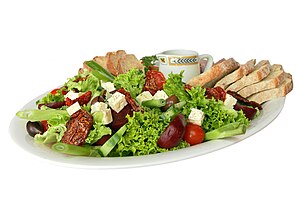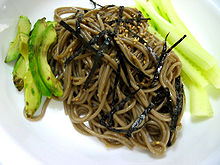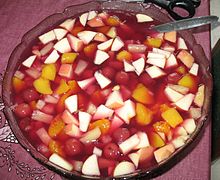| Revision as of 04:37, 6 January 2011 editManning Bartlett (talk | contribs)Autopatrolled, Extended confirmed users8,107 edits removed reference to "entree" (ambiguous word which means opposite things in US/UK)← Previous edit | Revision as of 04:50, 6 January 2011 edit undoManning Bartlett (talk | contribs)Autopatrolled, Extended confirmed users8,107 edits →Entrée salads: renamed to main course salads, added note about N. American usageNext edit → | ||
| Line 44: | Line 44: | ||
| Bound salads are often used as ] fillings. They are also popular at picnics and barbecues, because they can be made ahead of time and refrigerated. | Bound salads are often used as ] fillings. They are also popular at picnics and barbecues, because they can be made ahead of time and refrigerated. | ||
| === |
===Main course salads=== | ||
| ] salads, also known as "dinner salads"<ref name="Things to Do">Melissa Barlow, Stephanie Ashcraft Things to Do with a Salad: One Hundred One Things to Do With a Salad Gibbs Smith, 2006 ISBN 1-4236-0013-4, 9781423600138 128 pages page 7 </ref> and commonly known as "entrée salads" in North America) may contain grilled or fried chicken pieces, seafood such as grilled or fried shrimp or a fish steak such as ], ], or ]. Sliced steak, such as ] or skirt, can be placed upon the salad. ], ], ], ], and ] are types of dinner salad. | |||
| ===Fruit salads=== | ===Fruit salads=== | ||
Revision as of 04:50, 6 January 2011
This article is about the type of culinary dish. For other uses, see Salad (disambiguation).
| Part of a series on |
| Meals |
|---|
 |
| Meals |
| Components and courses |
| Related concepts |
Salad is any of a wide variety of dishes including: vegetable salads; salads of pasta, legumes, eggs, or grains; mixed salads incorporating meat, poultry, or seafood; and fruit salads. They may include a mixture of cold and hot, often including raw vegetables or fruits.
Green salads include leaf lettuce and leafy vegetables with a sauce or dressing. Other salads are based on pasta, noodles, or gelatin. Most salads are traditionally served cold, although some, such as south German potato salad, are served warm.
Green salads including leaf lettuces are generally served with a dressing, as well as various garnishes such as nuts or croutons, and sometimes with the addition of meat, fish, pasta, cheese, eggs, or whole grains.
Salads may be served at any point during a meal. They may be:
- Appetizer salads, light salads to stimulate the appetite as the first course of the meal.
- Side salads, to accompany the entrée as a side dish.
- Main dish salads, usually containing a portion of protein, such as chicken breast or slices of beef.
- Palate-cleansing salads, to settle the stomach after the main course.
- Dessert salads, sweet versions usually containing gelatin or whipped cream.
Etymology

The word "salad" comes from the French salade of the same meaning, from the Latin salata (salty), from sal (salt). (Other salt-related words include sauce, salsa, sausage, and salary). In English, the word first appears as "salad" or "sallet" in the 14th century.
Salt is associated with salad because vegetables were seasoned with brine or salty oil-and-vinegar dressings during Roman times.
The terminology "salad days", meaning a "time of youthful inexperience" (on notion of "green"), is first recorded by Shakespeare in 1606, while the use of salad bar first appeared in American English in 1976.
History
Food historians say the Romans ate mixed greens and dressing, and the Babylonians were known to have dressed greens with oil and vinegar two thousand years ago. In his 1699 book, Acetaria: A Discourse on Sallets, John Evelyn attempted with little success to encourage his fellow Britons to eat fresh salad greens. Royalty dabbled in salads: Mary, Queen of Scots, ate boiled celery root over salad covered with creamy mustard dressing, truffles, chervil, and slices of hard-boiled eggs.
The United States popularized salads in the late 19th century and other regions of the world adopted them throughout the second half of the 20th century. From Europe and the Americas to China, Japan, and Australia, salads are sold commercially in supermarkets for those who do not have time to compose a home-made salad, at restaurants (restaurants will often have a "Salad Bar" laid out with salad-making ingredients, which the customers will use to put together their salad) and at fast-food chains specializing in health food. In the US market, fast-food chains such as McDonald's and KFC, that typically sold "junk food" such as hamburgers, fries, and fried chicken, now sell packaged salads to appeal to the health-conscious.
Types of salads
Green salad

The "green salad" or "garden salad" is most often composed of leafy vegetables such as lettuce varieties, spinach, or rocket (arugula). Due to their low caloric density, green salads are a common diet food. The salad leaves are cut or torn into bite-sized fragments and tossed together (called a tossed salad), or may be placed in a predetermined arrangement.
Vegetable salad
Vegetables other than greens may be used in a salad. Common vegetables used in a salad include cucumbers, peppers, tomatoes, mushrooms, onions, spring onions, red onions, avocado, carrots, celery, and radishes. Other ingredients, such as olives, hard boiled egg, artichoke hearts, heart of palm, roasted red bell peppers, green beans, croutons, cheeses, meat (e.g. bacon, chicken), or seafood (e.g. tuna, shrimp), are sometimes added to salads.
Bound salad

A "bound" salad can be composed (arranged) or tossed (put in a bowl and mixed with a thick dressing). They are assembled with thick sauces such as mayonnaise. One portion of a true bound salad will hold its shape when placed on a plate with an ice-cream scoop. Examples of bound salad include tuna salad, pasta salad, chicken salad, egg salad, and potato salad.
Bound salads are often used as sandwich fillings. They are also popular at picnics and barbecues, because they can be made ahead of time and refrigerated.
Main course salads
Main course salads, also known as "dinner salads" and commonly known as "entrée salads" in North America) may contain grilled or fried chicken pieces, seafood such as grilled or fried shrimp or a fish steak such as tuna, mahi-mahi, or salmon. Sliced steak, such as sirloin or skirt, can be placed upon the salad. Caesar salad, Chef salad, Cobb salad, Greek salad, and Michigan salad are types of dinner salad.
Fruit salads
Fruit salads are made of fruit, and include the fruit cocktail that can be made fresh or from canned fruit.
Dessert salads
Dessert salads rarely include leafy greens and are often sweet. Common variants are made with gelatin or whipped cream (oftentimes with the brand products Jell-O and / or Cool Whip); e.g. jello salad, pistachio salad, and ambrosia. Other forms of dessert salads include snickers salad, glorified rice, and cookie salad popular in parts of the Midwestern United States.
Examples of salads


World Salads
Click here for a List of salads around the world.
Other Salads
The following is a list of additional salads:
- Bean salad
- Broccoli slaw
- Candle salad
- Caprese salad
- Chef salad
- Chicken salad
- Chinese chicken salad
- Coleslaw
- Congealed salad
- Cookie salad
- Crab Louie salad
- Egg salad
- Eggplant salad
- Fattoush
- Fruit salad
- Gado-gado
- Greek salad
- Ham salad
- Israeli salad
- Larb
- Niçoise salad
- Panzanella
- Pasta salad
- Potato salad
- Russian salad
- Salmagundi
- Seven-layer salad
- Shopska salad
- Somen salad
- Som tam
- Gỏi ngó sen - a Vietnamese salad
- Tabouli
- Taco salad
- Tuna salad
- Waldorf salad
- Watergate salad
Dressings


Sauces for salads are often called "dressings". The concept of salad dressing varies across cultures.
In Western culture, there are three basic types of salad dressing:
- Vinaigrette
- Creamy dressings, usually mayonnaise-based, but which may also contain yogurt, sour cream, buttermilk, milk, or crème fraîche
- Cooked dressings, which resemble creamy dressings, but are usually thickened by adding egg yolks and gently heating.
Vinaigrette Template:IPA-en is a mixture (emulsion) of salad oil and vinegar, often flavored with herbs, spices, salt, pepper, sugar, and other ingredients. It is used most commonly as a salad dressing, but also as a sauce or marinade.
There are many commonly used salad dressings in North America. Traditional dressings in southern Europe are vinaigrettes, while mayonnaise is predominant in eastern European countries and Russia. In Denmark, dressings are often based on crème fraîche.
In Asia, it is common to add sesame oil, fish sauce, citrus juice, or soy sauce to salad dressings.
The following are examples of common salad dressings:
- Blue cheese dressing
- Caesar dressing
- Extra virgin olive oil
- French dressing
- Honey Dijon
- Hummus
- Italian dressing
- Louis dressing
- Ranch dressing
- Rice vinegar
- Russian dressing
- Tahini
- Thousand Island dressing
- Vinaigrette
- Wafu dressing
Toppings and garnishes
Popular salad garnishes are nuts, croutons, anchovies, bacon bits (real or imitation), garden beet, bell peppers, shredded carrots, diced celery, cress, sliced cucumber, parsley, sliced mushrooms, sliced red onion, radish, sunflower seeds (shelled), real or artificial crab meat (surimi) and cherry tomatoes. Various cheeses, berries, seeds and other ingredients can also be added to green salads. Cheeses, in the form of cubes, crumbles, or grated, are often used, including blue cheese, Parmesan cheese, and feta cheese. Color considerations are sometimes addressed by using edible flowers, red radishes, carrots, various colors of peppers, and other colorful ingredients.
Salad records

The moshav (settlement) of Sde Warburg, Israel, holds the Guinness World Record for the largest lettuce salad, weighing 10,260 kg. The event, held on 10 November 2007, was part of the 70th anniversary celebration of the founding of the moshav. The salad was sold to participants and onlookers alike for 10 NIS per bowl, raising 100,000 NIS (over $25,000) to benefit Aleh Negev, a rehabilitative village for young adults suffering from severe physical and cognitive disabilities. Major General (Res.) Doron Almog, Chairman of Aleh Negev was present to accept the donation and commended the residents, who had grown the lettuce and prepared the salad on the moshav. The volunteer effort to prepare the salad itself took all day and most of the residents, ranging from many of the original founders of the moshav to young children, participated.
See also
References
- Encyclopedia Britanica
- ^ Harper, Douglas. "salad". Online Etymology Dictionary.
- Food Timeline's History of Salads
- ^ Hungry Monster's History of Salad Dressings
- Salad Recipe's The Story of Salad's Success
- Chef Talk's History of Salad
- ^ Melissa Barlow, Stephanie Ashcraft Things to Do with a Salad: One Hundred One Things to Do With a Salad Gibbs Smith, 2006 ISBN 1-4236-0013-4, 9781423600138 128 pages page 7
- BBC Good Food
- Aleh Negev